Characterization of Surface α-Particle Radiation, Internal Traceability and Simulation of Typical Tin Spheres
Abstract
1. Introduction
2. Alpha Decay Properties of Common Nuclides
3. Measurement Tests
3.1. Sample
3.2. Test Results and Analysis
4. Monte Carlo Simulation
4.1. SRIM Simulation Results and Analysis
4.2. Geant4 Simulation Results and Analysis
5. Conclusions
Author Contributions
Funding
Institutional Review Board Statement
Informed Consent Statement
Data Availability Statement
Conflicts of Interest
References
- May, T.C.; Woods, M.H. Alpha-particle-induced soft errors in dynamic memories. IEEE Trans. Electron. Dev. 1979, 26, 2. [Google Scholar] [CrossRef]
- Anlin, H.E.; Guo, G.; Shen, D. Proton Induced Single Event Upsets Test and Soft Error Rate Prediction of nm Device. Annu. Rep. China Inst. At. Energy 2017, 93–94. [Google Scholar]
- Zhang, Z.; Ye, B.; Ji, Q.; Guo, J.; Xi, K.; Lei, Z.; Huang, Y.; Peng, C.; He, Y.; Liu, J.; et al. Study of alpha particle soft error mechanism in nanoscale static random access memory. Acta Phys. Sinica 2020, 69, 255–263. [Google Scholar]
- Bhuva, B. Soft error trends in advanced silicon technology nodes. In Proceedings of the 2018 IEEE International Electron Devices Meeting (IEDM), San Francisco, CA, USA, 1–5 December 2018; p. 34.4.1. [Google Scholar]
- Lei, Z.F.; Zhang, Z.G.; En, Y.F.; Huang, Y. Mechanisms of atmospheric neutron-induced single event upsets in nanometric SOI and bulk SRAM devices based on experiment-verified simulation tool. Chin. Phys. B 2018, 27, 338–342. [Google Scholar] [CrossRef]
- Wang, X.; Zhang, F.Q.; Chen, W.; Guo, X.Q.; Ding, L.L.; Luo, Y.H. Assessment of the application of the China Scattered Neutron Source to the study of atmospheric neutron single-particle effects. Acta Phys. Sin. 2019, 68, 44–53. [Google Scholar]
- JESD89; A Measurement and Reporting of Alpha Particle and Terrestrial Cosmic Ray-Induced Soft Errors in Semiconductor Devices. JEDEC Standard: Arlington, VA, USA, 2006.
- Auden, E.C.; Quinn, H.M.; Wender, S.A.; O’ Donnell, J.M.; Lisowski, P.W.; George, J.S.; Xu, N.; Black, D.A.; Black, J.D. Thermal Neutron-Induced Single-Event Upsets in Microcontrollers Containing Boron-10. IEEE Trans. Nucl. Sci. 2020, 67, 29. [Google Scholar] [CrossRef]
- Weulersse, C.; Houssany, S.; Guibbaud, N.; Segura-Ruiz, J.; Beaucour, J.; Miller, F.; Mazurek, M. Contribution of Thermal Neutrons to Soft Error Rate. IEEE Trans. Nucl. Sci. 2018, 65, 1851–1857. [Google Scholar] [CrossRef]
- Autran, J.L.; Munteanu, D.; Sauze, S.; Gasiot, G.; Roche, P. Accurate Resolution of Time-Dependent and Circuit-Coupled Charge Transport Equations: 1-D Case Applied to 28-nm FD-SOI Devices. In Proceedings of the 2014 IEEE Radiation Effects Data Workshop (REDW), Paris, France, 14–18 July 2014; p. 1. [Google Scholar]
- Ai, Y. Soft errors induced by alpha particles in large-scale integrated circuits and measures to reduce soft errors. J. Jixi Univ. 2003, 57–58. [Google Scholar] [CrossRef]
- Claeys, C.L.; Simoen, E. Radiation Effects in Advanced Semiconductor Materials and Devices; Springer: Berlin/Heidelberg, Germany, 2002. [Google Scholar]
- Li, J.; Li, J.; Ding, Y.; Liu, C.; Hou, X.; Chen, H.; Xiong, Y.; Zhang, D.W.; Chai, Y.; Zhou, P. Highly Area-Efficient Low-Power SRAM Cell with 2 Transistors and 2 Resistors. In Proceedings of the 2019 IEEE International Electron Devices Meeting (IEDM), San Francisco, CA, USA, 7–11 December 2019. [Google Scholar]
- Lee, S.; Uemura, T.; Monga, U.; Choi, J.H.; Kim, G.; Pae, S. Soft error rate analysis for incident angle and N-well structure dependencies using small-sized alpha source in 10 nm FinFET technology. In Proceedings of the 2017 IEEE International Reliability Physics Symposium (IRPS), Monterey, CA, USA, 2–6 April 2017; pp. SE.1.1–SE.1.4. [Google Scholar]
- Uemura, T.; Lee, S.; Monga, U.; Choi, J.; Lee, S.; Pae, S. Technology Scaling Trend of Soft Error Rate in Flip-Flops in 1 × nm Bulk FinFET Technology. IEEE Trans. Nucl. Sci. 2018, 65, 1255–1263. [Google Scholar] [CrossRef]
- Fang, Y.P.; Oates, A.S. Soft errors in 7nm FinFET SRAMs with integrated fan-out packaging. In Proceedings of the 2018 IEEE International Reliability Physics Symposium (IRPS), Burlingame, CA, USA, 11–15 March 2018. [Google Scholar]
- Luo, J.; Zhang, Z.; Lei, Z.; Chen, Z.; Peng, C.; Yue, S.; Zhang, H.; Zhong, X.; Sun, C.; Huang, Y.; et al. Ultra-low background α-particle testing technology and experimental research on electronic materials. Electron. Prod. Reliab. Environ. Test. 2022, 40, 37–41. [Google Scholar]
- Jiao, Y.; Jermsittiparsert, K.; Krasnopevtsev, A.Y. Interaction of thermal cycling and electric current on reliability of solder joints in different solder balls et al. Mater. Res. Express 2019, 6, 106302. [Google Scholar] [CrossRef]
- Chia JY, H.; Cotterell, B.; Chai, T.C.; Cotterell, B.; Chai, T.C. The mechanics of the solder ball shear test and the effect of shear rate. Mater. Sci. Eng. A 2006, 417, 259–274. [Google Scholar] [CrossRef]
- Persson, B.; Holm, E. Polonium-210 and lead-210 in the terrestrial environment a historical review. J. Environ. Radioact. 2011, 102, 420–429. [Google Scholar] [CrossRef] [PubMed]
- Available online: https://xia.com/support/ultralo-1800/ (accessed on 10 January 2024).
- The Stopping and Range of Ions in Matter, Ziegler J F. Available online: http://www.srim.org/ (accessed on 17 January 2024).
- Battistoni, G.; Boehlen, T.; Cerutti, F.; Boehlen, T.; Cerutti, F.; Chin, P.W.; Esposito, L.S.; Fassò, A.; Ferrari, A.; Lechner, A.; et al. Overview of the FLUKA code. Ann. Nucl. Energy 2015, 82, 10. [Google Scholar] [CrossRef]
- Díaz-Francés, J.A.; Cortés-Giraldo, M.A.; Jiménez-Ramos, M.C.; Hurtado-Bermúdez, S. Simulation of the response of a PIPS detector using GEANT4 code. Nucl. Instrum. Methods Phys. Res. Sect. A Accel. Spectrometers Detect. Assoc. Equip. 2017, 875, 21–26. [Google Scholar] [CrossRef]
- Moslehi, A.; Baradaran, S.; Taheri, M. The microdosimetic one-hit detector model for calculating the alpha particles detection efficiency of polycarbonate SSNTD. Nucl. Instrum. Methods Phys. Res. Sect. A Accel. Spectrometers Detect. Assoc. Equipment. 2022, 1033, 166714. [Google Scholar] [CrossRef]
- Geant4 Collaboration. “Geant4: A Simulation Toolkit”, Physics Reference Manual, Release 11.1. 2022. Available online: https://geant4-userdoc.web.cern.ch/UsersGuides/PhysicsReferenceManual/fo/PhysicsReferenceManual.pdf (accessed on 15 January 2024).
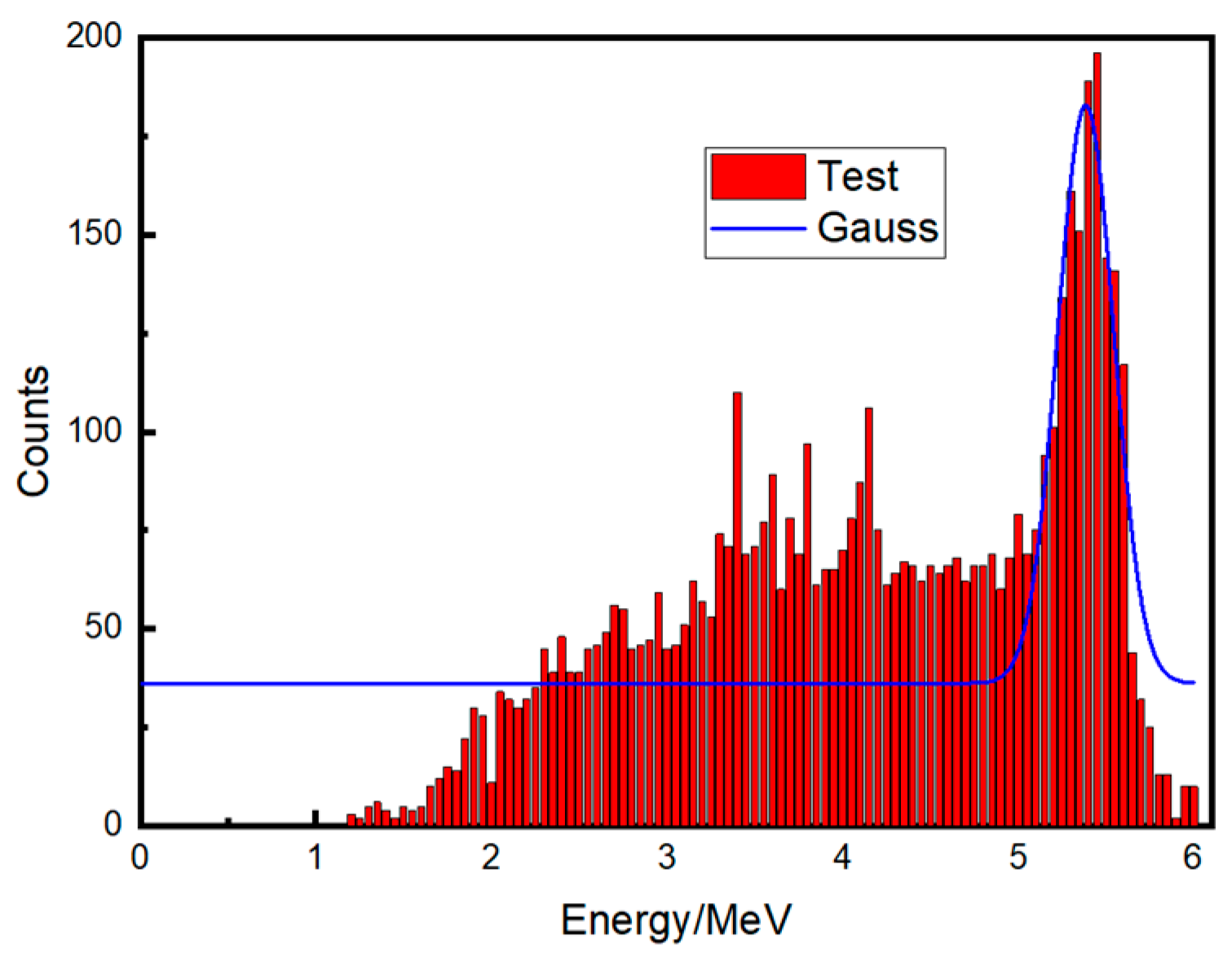


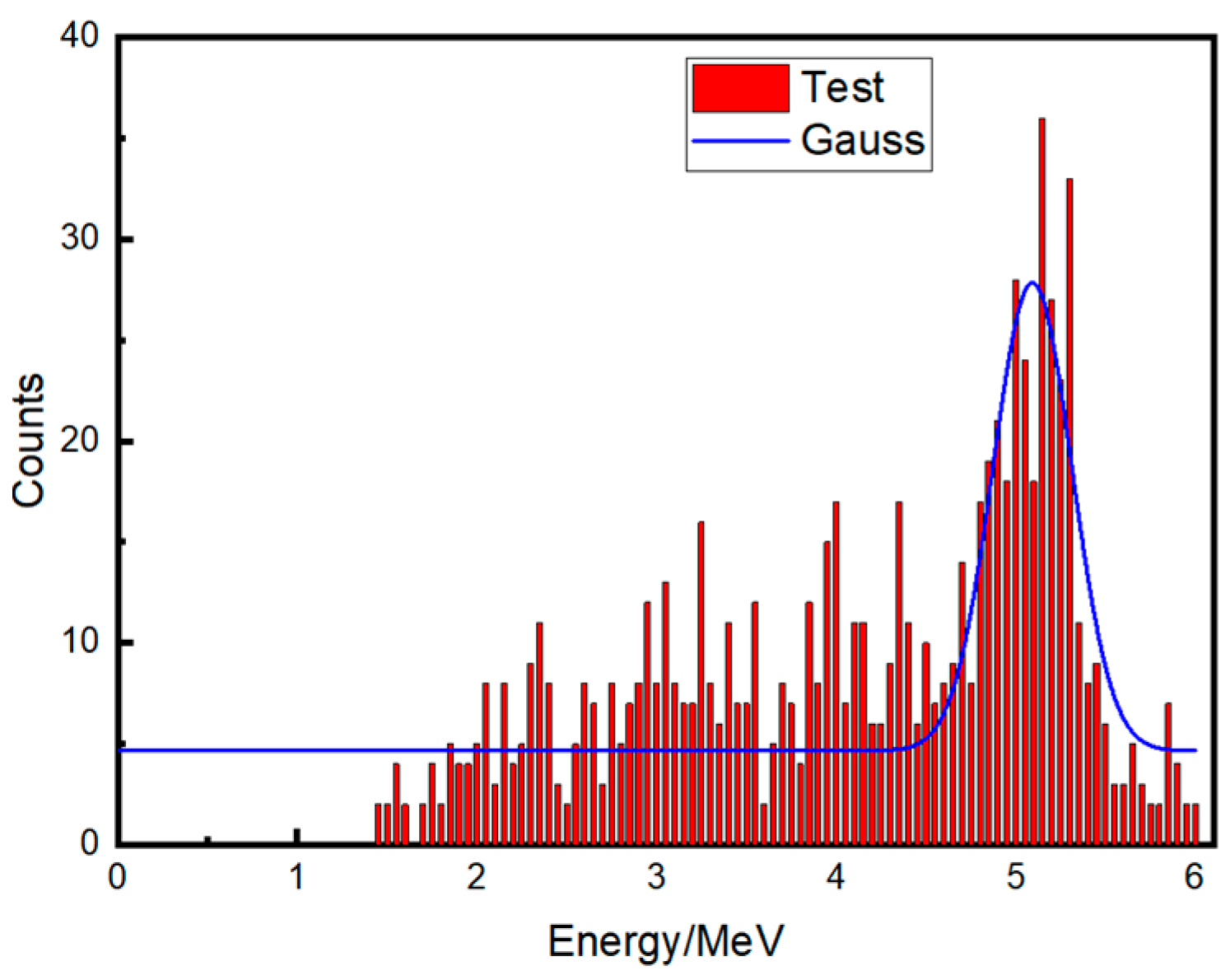


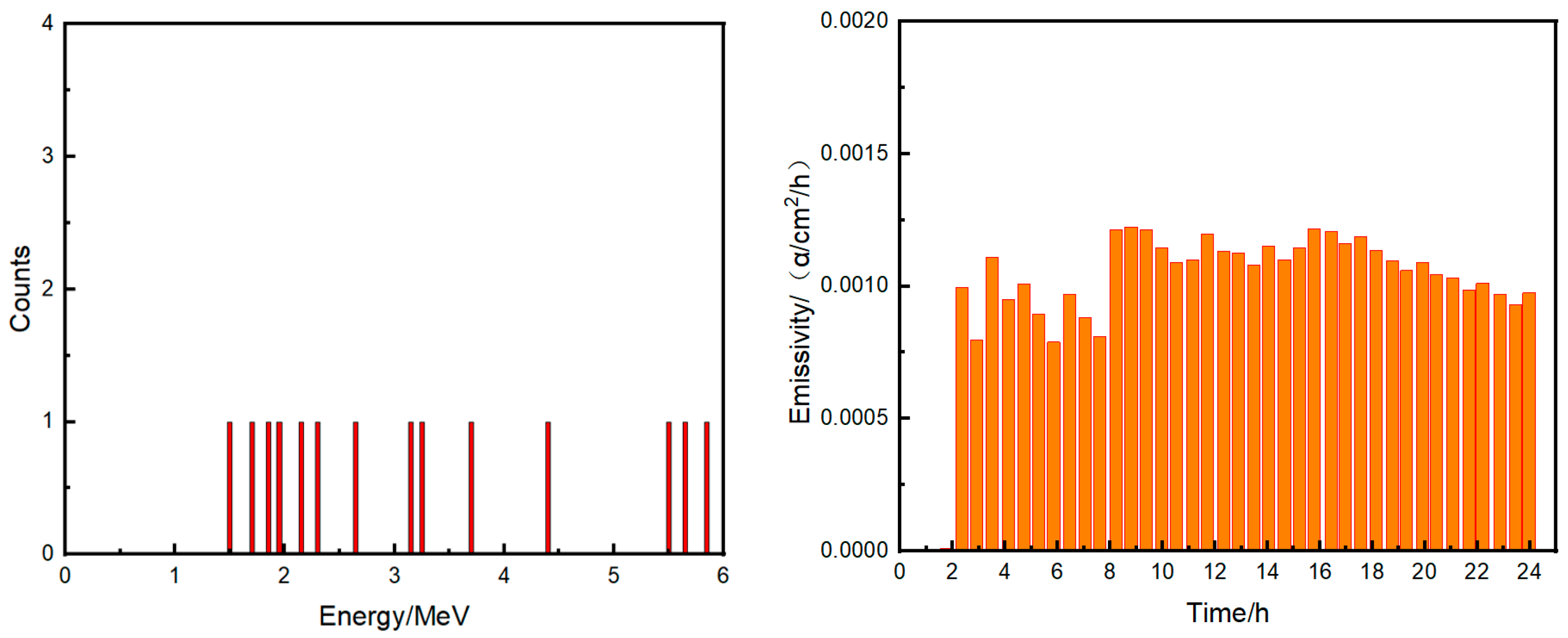

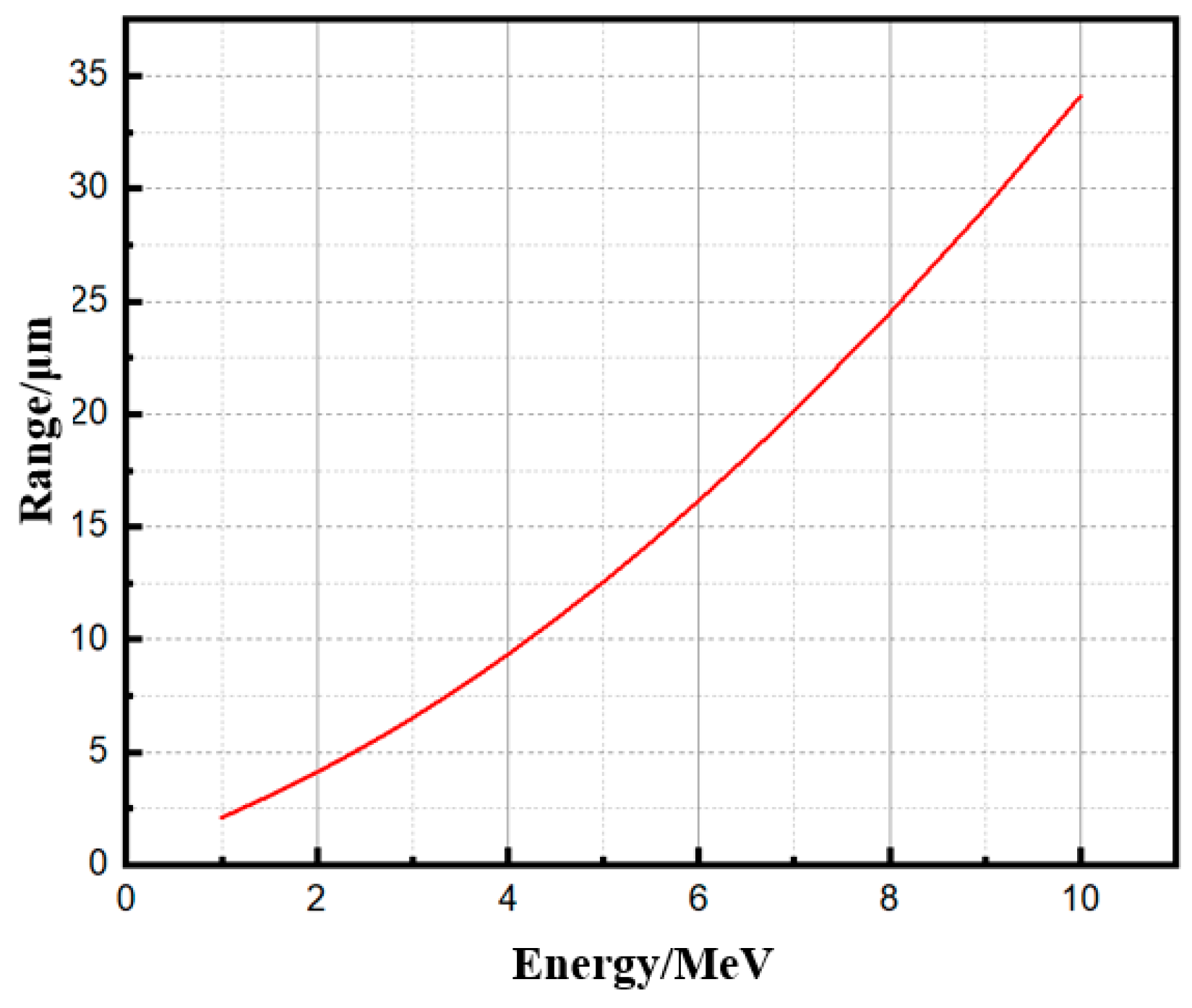
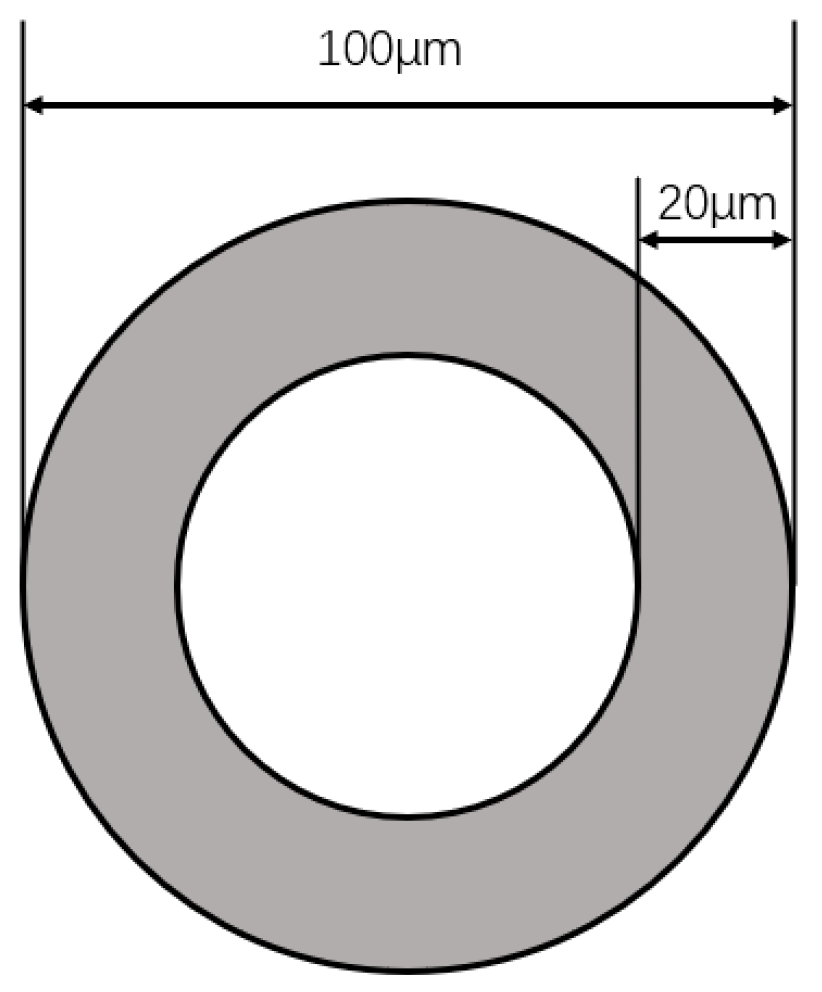
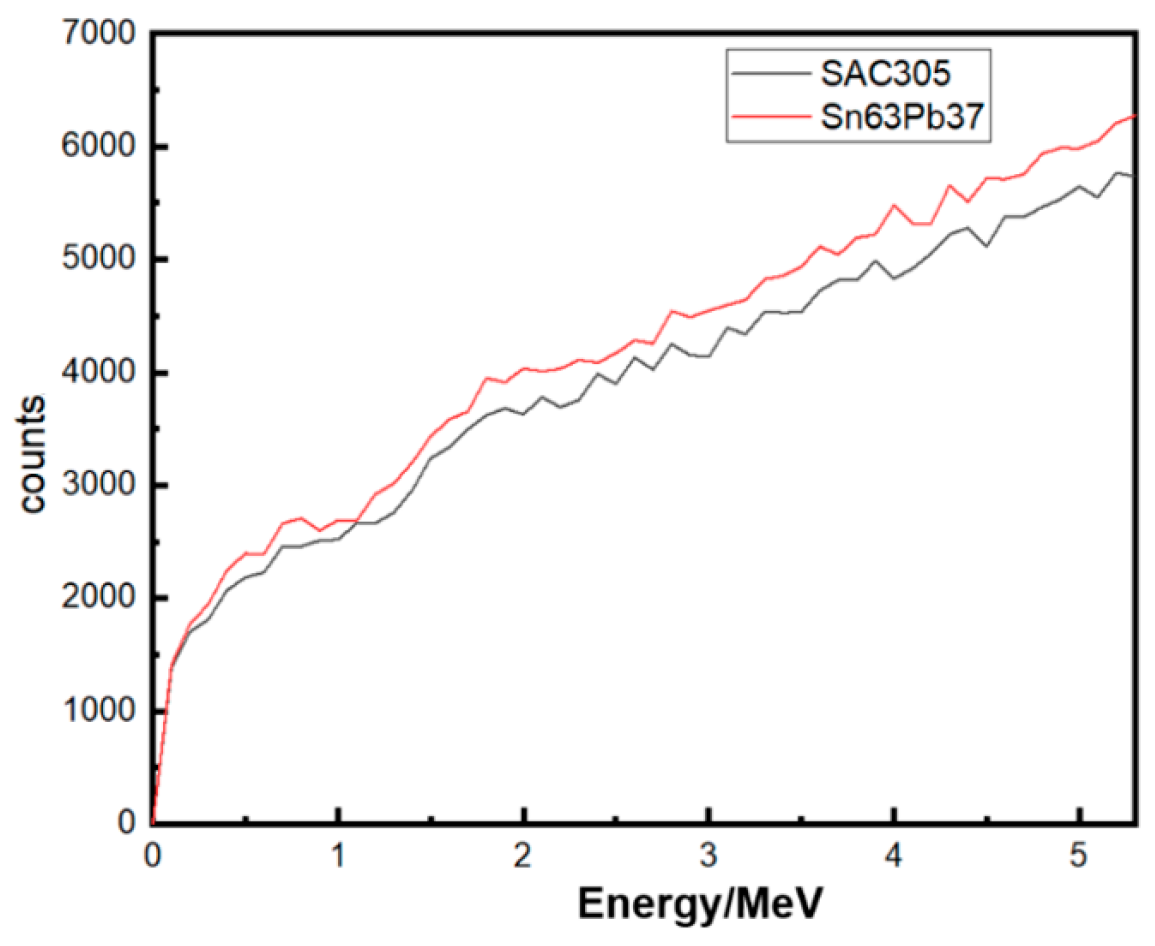
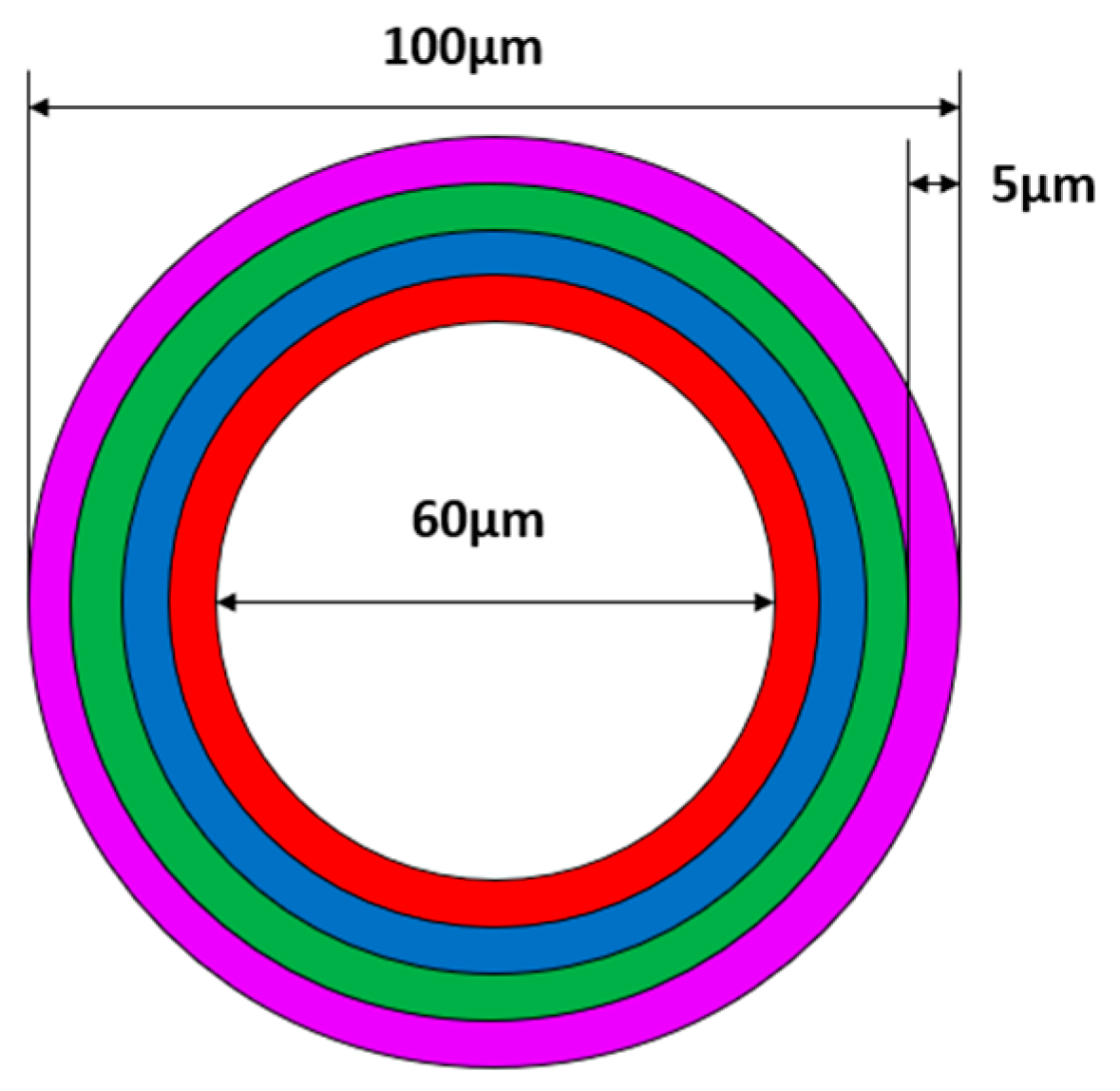
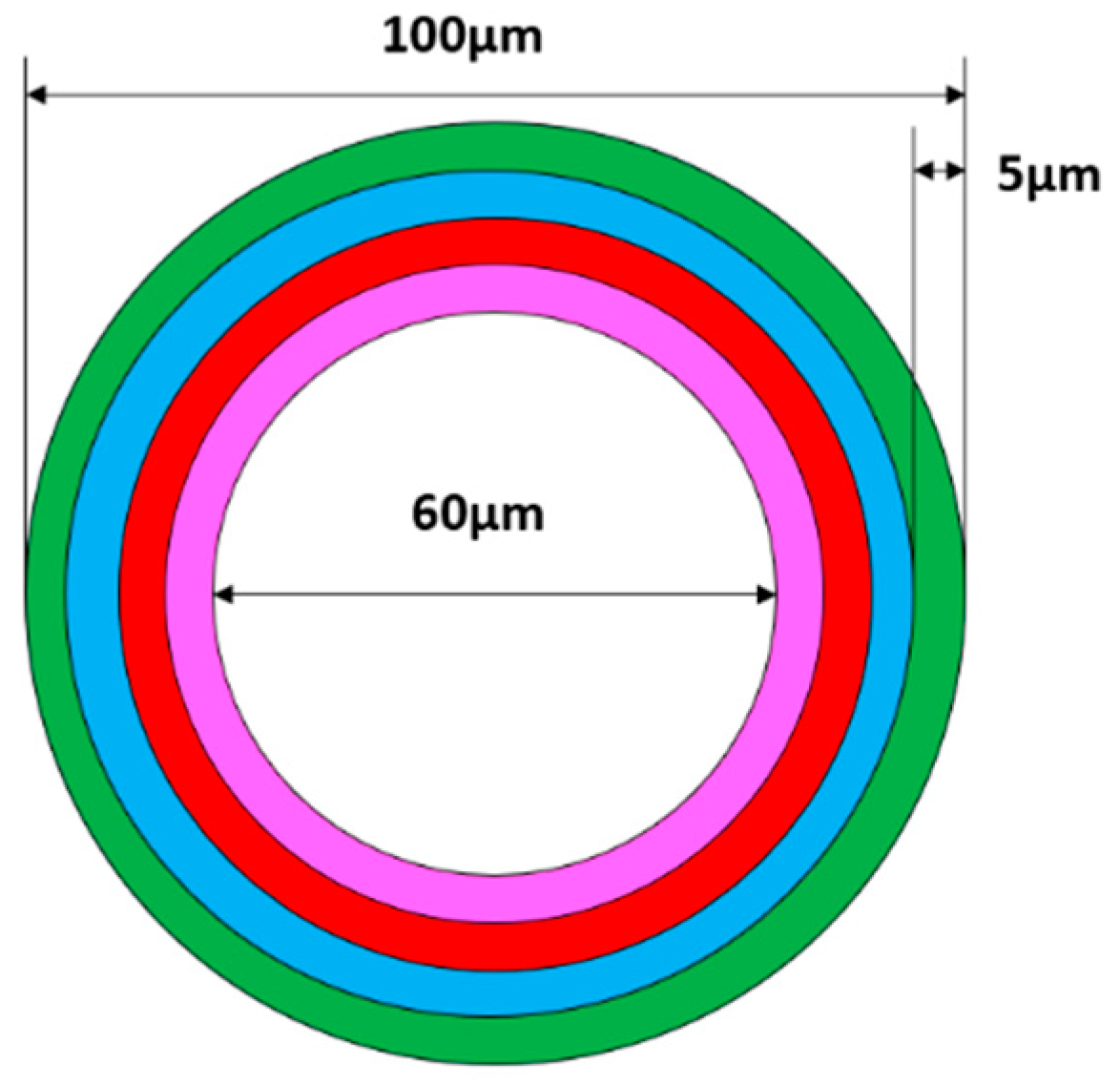
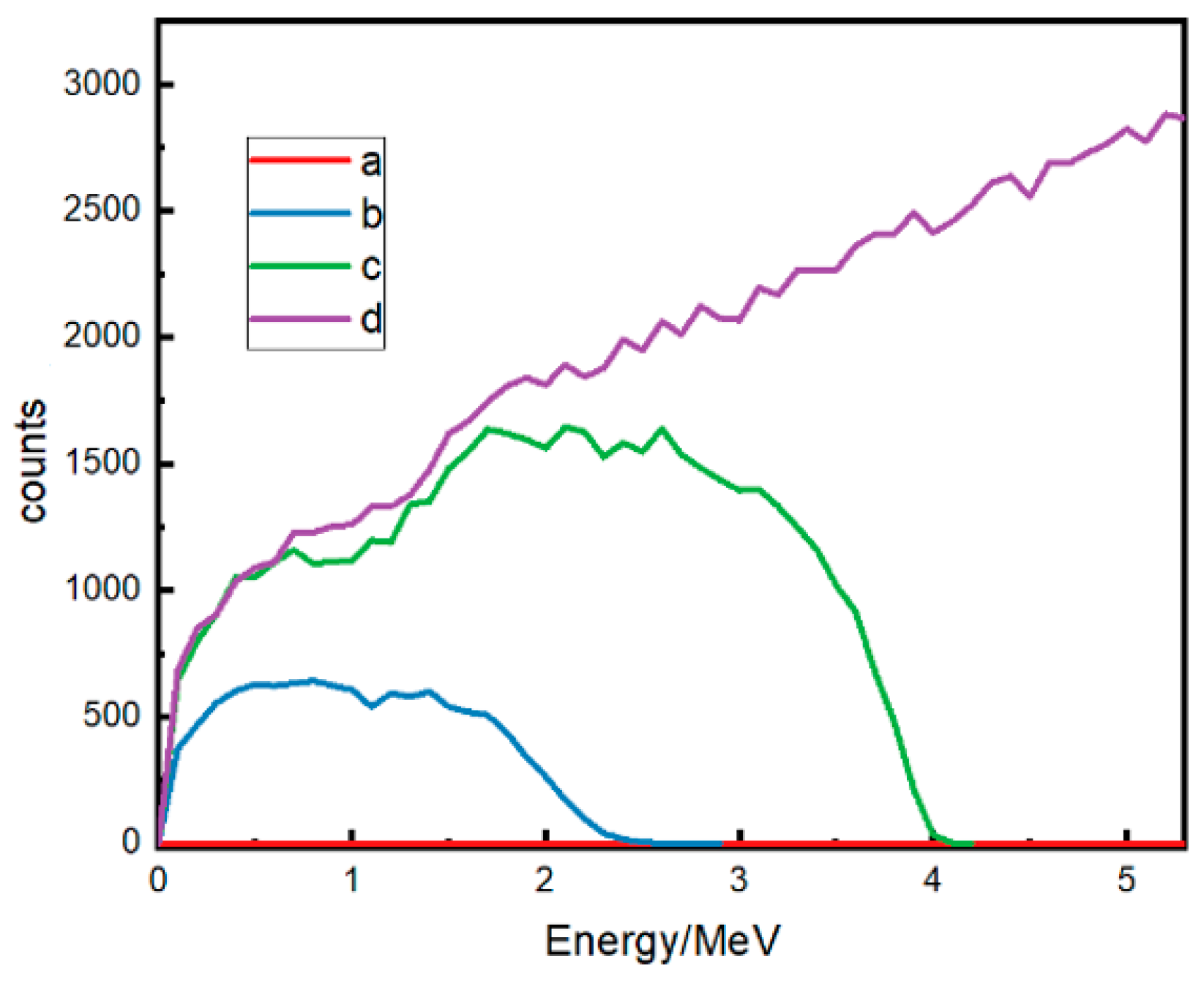
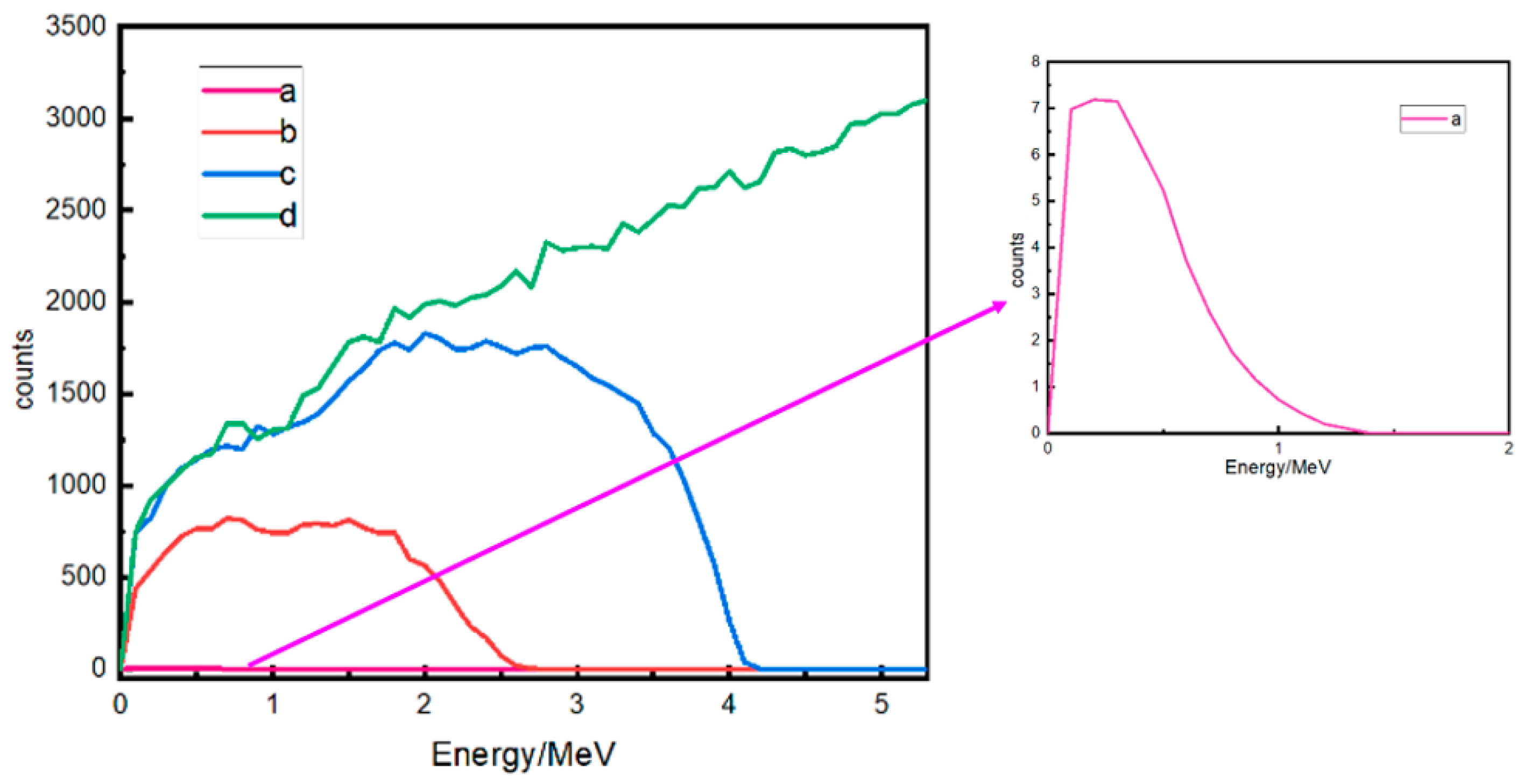
| Parent Nuclide | T1/2 | Type of Decay | Decaying Alpha Particle Energy/MeV | Radio Nuclide |
|---|---|---|---|---|
| 238U | 4.468 × 109 y | α | 4.198 (79%), 4.151 (21%) | 234Th |
| 234Th | - | β | - | 234Pa |
| 234Pa | - | β | - | 234U |
| 234U | 2.455 × 105 y | α | 4.775 (71%), 4.772 (28%) | 230Th |
| 230Th | 7.538 × 104 y | α | 4.687 (76%), 4.620 (23%) | 226Ra |
| 226Ra | 1600 y | α | 4.784 (94%), 4.601 (6%) | 222Rn |
| 222Rn | 3.8 d | α | 5.489 | 218Po |
| 218Po | 3.1 s | α | 6.002 | 214Pb |
| 214Pb | - | β | - | 214Bi |
| 214Bi | - | β | - | 214Po |
| 214Po | 163 μs | α | 7.687 | 210Pb |
| 210Pb | 22.2 y | β | - | 210Bi |
| 210Bi | 5 d | β | - | 210Po |
| 210Po | 138 d | α | 5.304 | 206Pb |
| Group | Sample Composition | Ball Diameter | Densities (g/cm3) |
|---|---|---|---|
| 1# | Sn10%Pb90% | 0.1 mm | 10.7 |
| 2# | Sn63%Pb37% | 0.1 mm | 7.34 |
| 3# | SnAg3.0%Cu0.5% | 0.1 mm | 8.84 |
| 4# | LowαSn10%Pb90% | 0.1 mm | 10.7 |
| 5# | LowαSnAg3.0%Cu0.5% | 0.1 mm | 7.34 |
| 6# | LowαSn63%Pb37% | 0.1 mm | 8.84 |
| Group | Sample Composition | Ball Diameter | α-Particle Emissivity α/(cm2·h) |
|---|---|---|---|
| 1# | Sn10%Pb90% | 0.1 mm | 85.12 ± 0.7 |
| 2# | Sn63%Pb37% | 0.1 mm | 8.47 ± 0.2 |
| 3# | SAC305 | 0.1 mm | 3.76 ± 0.2 |
| 4# | Low α Sn10%Pb90% | 0.1 mm | 0.0019 ± 0.00035 |
| 5# | Low α Sn63%Pb37% | 0.1 mm | 0.0017 ± 0.00029 |
| 6# | Low α SAC305 | 0.1 mm | 0.0010 ± 0.00048 |
| Alpha Particle Emissivity Class | Emissivity (α/(cm2·h)) |
|---|---|
| Uncontrolled Alpha | >0.05 |
| Low Alpha | 0.002~0.05 |
| Ultra Low Alpha (ULA) | <0.002 |
Disclaimer/Publisher’s Note: The statements, opinions and data contained in all publications are solely those of the individual author(s) and contributor(s) and not of MDPI and/or the editor(s). MDPI and/or the editor(s) disclaim responsibility for any injury to people or property resulting from any ideas, methods, instructions or products referred to in the content. |
© 2024 by the authors. Licensee MDPI, Basel, Switzerland. This article is an open access article distributed under the terms and conditions of the Creative Commons Attribution (CC BY) license (https://creativecommons.org/licenses/by/4.0/).
Share and Cite
Liu, L.; Zhang, Z.; Zhang, H.; Li, H.; Lei, Z.; Luo, J.; Peng, C.; Sun, C.; He, Y. Characterization of Surface α-Particle Radiation, Internal Traceability and Simulation of Typical Tin Spheres. Appl. Sci. 2024, 14, 4257. https://doi.org/10.3390/app14104257
Liu L, Zhang Z, Zhang H, Li H, Lei Z, Luo J, Peng C, Sun C, He Y. Characterization of Surface α-Particle Radiation, Internal Traceability and Simulation of Typical Tin Spheres. Applied Sciences. 2024; 14(10):4257. https://doi.org/10.3390/app14104257
Chicago/Turabian StyleLiu, Longfei, Zhangang Zhang, Hong Zhang, Hui Li, Zhifeng Lei, Junyang Luo, Chao Peng, Changhao Sun, and Yujuan He. 2024. "Characterization of Surface α-Particle Radiation, Internal Traceability and Simulation of Typical Tin Spheres" Applied Sciences 14, no. 10: 4257. https://doi.org/10.3390/app14104257
APA StyleLiu, L., Zhang, Z., Zhang, H., Li, H., Lei, Z., Luo, J., Peng, C., Sun, C., & He, Y. (2024). Characterization of Surface α-Particle Radiation, Internal Traceability and Simulation of Typical Tin Spheres. Applied Sciences, 14(10), 4257. https://doi.org/10.3390/app14104257





